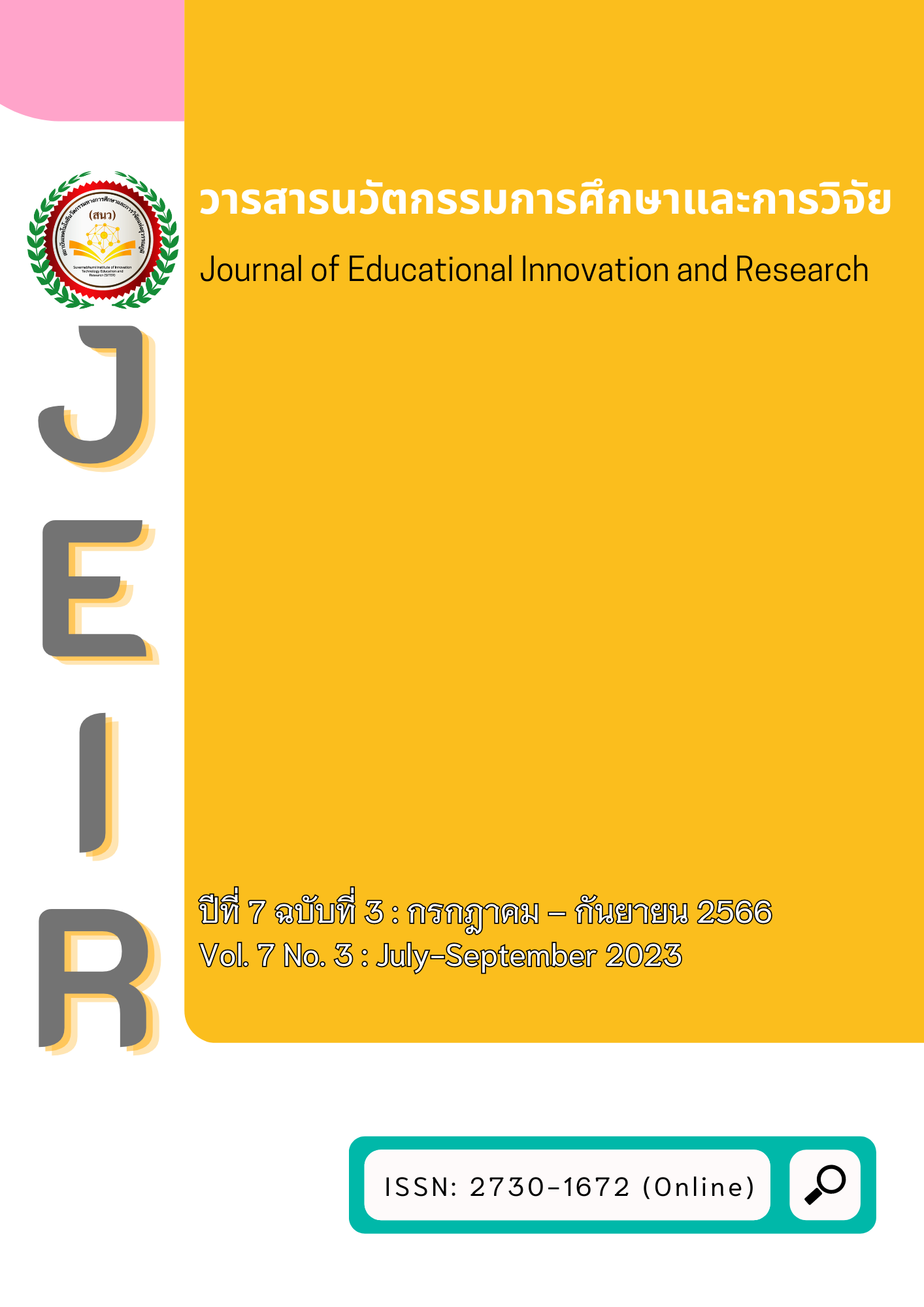The Priority Needs of Developing Academic Management based on the Concept of Financial Literacy: A Case Study of an Elementary School in Kamphaeng Phet
Main Article Content
บทคัดย่อ
This article aimed to study 1) the present state of developing academic management based on the concept of financial literacy 2) the desirable state of developing academic management based on the concept of financial literacy and 3) the needs state of developing academic management based on the concept of financial literacy. Informants were director, vice director and 32 teachers of the school. They were selected by purposive sampling. The instrument for collecting data was questionnaire and analyzing by descriptive statistics and content analysis. The research results were found as follows; 1) the present states of academic management of the school based on the concept of financial literacy were medium level (𝑥̅ = 3.30) 2) the desirable states were the highest level (𝑥̅ = 4.78) and 3) The priority was 0.48 (PNImodified = 0.48). In addition, the highest priority was curriculum development and when considering the components of financial literacy, curriculum development for students to understand the concept of interest had the highest priority. Then, the second priority was assessment and evaluation. When considering the components of financial literacy, assessment and evaluation for students to understand the concept of interest had the highest priority. Lastly, the third priority was learning management and when considering the components of financial literacy, instructional management for students to understand the concept of interest had the highest priority. The results help an elementary school to realize the needs of developing academic management based on financial literacy to support teachers and educational personnel to improve curriculum development, instructional management, and measurement and evaluation of the school to enhance financial literacy of the students effectively.
Article Details

อนุญาตภายใต้เงื่อนไข Creative Commons Attribution-NonCommercial-NoDerivatives 4.0 International License.
เอกสารอ้างอิง
Atkinson A. and Messy F. (2012). Measuring financial literacy: Results of the OECD / International Network on Financial Education (INFE) Pilot Study. OECD Working Papers on Finance, Insurance and Private Pensions, No. 15. Paris: OECD Publishing.
Amagir, A., Groot, W., Maassen van den Brink, H., & Wilschut, A. (2018). A review of financial-literacy education programs for children and adolescents. Citizenship, Social and Economic Education, 17(1), 56-80.
Asawapoom A. (2008). Modern Educational Administration: Concepts, Theory and Practice. Ubon Ratchathani: Ubonkit Offset.
Bank of Thailand. (2020). Financial Access Survey of Thai Households 2020. Retrieved March 11, 2022, from https://www.bot.or.th/English/FinancialInstitutions/Highlights/DocLib_FinancialAcc essSurveyOfThaiHouseholds_2020/2020FinancialAccessSurveyOfThaiHouseholds.pdf
Belás, J., Nguyen, T. A. N., Smrčka, L., Kolembus, J., & Cipovová, E. (2016). Financial literacy of secondary school students Case study from the Czech Republic and Slovakia. Economics and Sociology. 9(4), 191–206.
Hillyer, B. J. (1993). The impact of portfolios on second grade students self-assessment of their literacy development. Dissertation Abstracts International, 54, 446
Holden, K., Kalish, C., Scheinholtz, L., Dietrich, D., & Novak, B. (2009). Financial literacy programs targeted on pre-school children: Development and evaluation. Credit Union National Association (CUNA).
Huston, S. J. (2010). Measuring financial literacy. Journal of consumer affairs, 44(2), 296-316.
IPST. (2022). School project manual for quality science, mathematics and technology according to IPST standards. Retrieved April 29, 2022, from https://drive.google.com/file/d/1FvI_aI9l_ dYOBM fLEacuaj_boHUr5FpL/view
Kao-ian J. (2014). Techniques for academic management in educational institutions, strategies and practice guidelines for executive professionals. Songkla: Chanmueng Printing.
Langrall, C., Mooney, E., Nisbet, S., & Jones, G. (2008). Elementary students’ access to powerful mathematical ideas. Handbook of international research in mathematics education, 109-135, New York: Routledge.
Lusardi, A. (2008). Financial literacy: an essential tool for informed consumer choice?, Working Paper, Dartmouth College.
Mariappan, et al. (2004). Scenario-based Learning Approach in Teaching Statics. Paper Presented at Proceedings of the 2004 American Society for Engineering Education Annual Conference and Exposition, 1-7.
Ministerial Regulations define rules and procedures for decentralization of administration and education 2007. (2007). Royal Gazette. Vol. 124 Part 24. 29-30.
Ministry of Education. (2022). Policy and Focus Points of the Ministry of Education Fiscal Year 2022 and 2023. Royal Gazette.
OECD. (2016). 2016 OECD/INFE International Survey of Adult Financial Literacy Competencies. INFE International Network and Financial Education. Retrieved April 30, 2022, from https://www.oecd.org/daf/fin/financial-education/OECD-INFE-International-Survey-of Adult-Financial-Literacy-Competencies.pdf
OECD. (2016). G20/OECD INFE Core competencies framework on financial literacy for adults. Retrieved March 11, 2022, from www.oecd.org/finance/Core- Competencies-Framework-Adults.pdf
OECD. (2015). National Strategies for Financial Education OECD/INFE Policy Handbook. Retrieved March 11, 2022, from https://www.oecd.org/finance/National-Strategies-Financial-Educa tion-Policy-Handbook.pdf
Sakondhawat, K., & Triwaranyu, C. (2020). The Development of the Economic Learning Activity Package Using Scenario-based Learning to Promote the Financial Literacy of Lower Secondary School Students. Silpakorn Educational Research Journal, 12(2), 34-52.
Sergiovanni, T. J. (1987). The principalship: A reflective practice perspective. Publication Sales, Allyn and Bacon, Longwood Division , 7 Wells Avenue, Newton, MA 02159.
Siam Commercial Bank.(2021). How important of Financial Literacy and why we need to undertand?. Retrieved April 29, 2022, from https://www.scb.co.th/th/personal-banking/stories/tips-for-you/financial-literacy-important.
Sorin, R. (2013). Exploring Partnerships in Early Childhood Teacher Education through Scenario-based Learning. World Journal of Education, 3(1), 39-45.
Tarasrisuth, P. (2007). Organization and administration of academic management. Bangkok: Ramkhamhaeng University Press.
Viseshsiri, P. (2012). Academic administration and quality assurance handout for course 2747732. Bangkok: Chulalongkorn University.
Vehachart, R.(2007). Administrational management and school base basic. Songkhla: Thaksin University.
Wattanachai, K.(2012).Philosophy of Sufficiency Economy and its application in life and organizational development. Retrieved April 29, 2022, from http://social.nesdc.go.th/social/Default.aspx? tabid=126&articleType=ArticleView&articleId=114
Wongnuaroj, P. (2010). Academic Administration. Bangkok: Bangkok Media Center.
Yunikawati, N. A., Priambodo, M. P., Puspasari, E. Y., & Istiqomah, N. M. (2021). Is it Important for Elementary School Students to Learn the Basics of Finance?. in International Research Conference on Economics and Business, KnE Social Sciences, 41-48.


